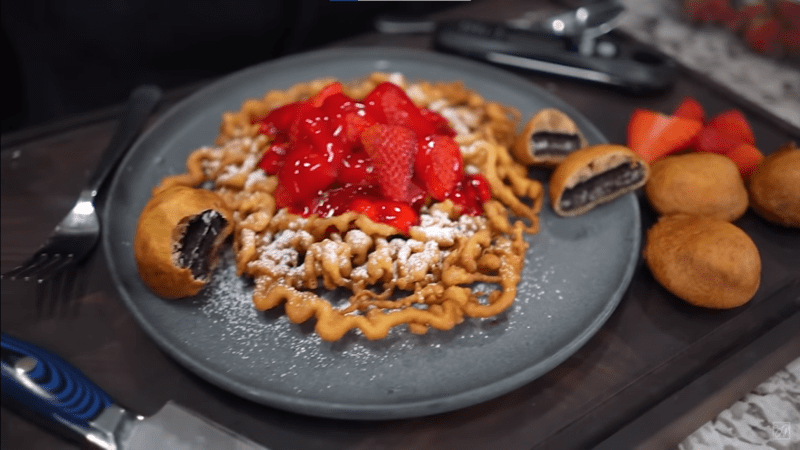Summer is coming, which means that carnivals and street fairs are ready to sell you a fried treat. At one stand, you are served a funnel cake fresh from the fryer and dusted in powdered sugar. Then at another, the scent of cinnamon sugar catches your nose making you crave an elephant ear.
These two doughboys are sometimes confused with one another by tourists traveling in the United States during summer. They look similar and both are cooked in a vat of boiling oil. Here are ways to identify and know the difference between funnel cake and elephant ear.
Funnel Cake: A Pancake Fritter Clump
Funnel cake is a fried fritter dessert. Its original recipe dates back to 1390 AD, in the Middle-English cookbook, The Forme of Cury. The funnel cake is a medieval Persian treat that grew popular around Anglo-Norman regions of Europe.
The Funnel Name
There were no funnels during the Medieval era. Instead, cooks would use a bowl with a hole in the bottom to carefully drop the batter in hot oil. Funnel cake’s former name, Mistembec came from the French instruction “mis en bec”, translating to “put in spout”. When served, the cooks either drizzle syrup on them or sprinkle sugar on top.
Its name and cooking method soon changed in an 1898 The Ladies’ Home Journal issue. In the Recipes section, the funnel cake was called Sweet Raglets for its puffy ripples. The issue replaces the spout bowl with a pastry pipe bag to control the batter without making a mess in the kitchen.
This delectable dessert would be introduced to Americans by German immigrants in Pennsylvania in 1950. They shared the funnel cake in Lancaster while hosting the Kutztown Folk Festival to share their lifestyle, religion, and the country’s folktales. They sold it as Dretcher Kuche, or what we know now as funnel cake.
Pancake Batter Fritters
During Medieval times, funnel cake would be made with a yeast or sourdough starter to help the batter rise as it cooks in oil. In the 1898 recipe for Sweet Raglets, it added butter and eggs to keep the batter firm while frying. Nowadays, funnel cake uses pancake batter to create a fritter clump.
Pastry chefs and fair food cooks make funnel cake as a bed of batter streaks. Chefs can drizzle the mixture through a bag, a funnel gun, or a kettle pitcher. This fried lumpy cluster is still served with powdered sugar and syrup today.
When you bite into the funnel cake, you should hear a light crunch from its crispy exterior. Its fluffy texture will soon melt in your mouth as you chew. And the flavor syrup it absorbs will prevent your tongue from being overwhelmed by the oil.
If you need a classic funnel cake with a fruity topping, try Chef AB’s confection overdose from Smokin’ and Grillin’!
Elephant Ear: Sweet Navajo Fry Bread
Elephant ear in North America is a fried sweet bread dessert. Not to be confused with the other elephant ear desserts such as palmiers and gosh-e fil, they do share their sweet puffy roots. It came from its savory counterpart, Navajo fry bread. This bread kept the Navajo tribe fed during the Long Walk, the relocation movement that moved the Navajo from Arizona to New Mexico.
Elephant Ear Unknown Fair Food Origin
Navajo fry bead was made in 1864 out of necessity. According to Indianapolis Monthly, the bread was made when the U.S. government provided the Navajo tribe with flour, sugar, canned goods, lard, and salt. It can be made as sweet or savory.
It is unknown when the elephant ear became popular and appeared at US street fairs in the midwest. Will food enthusiasts ever find the first stand that sold it? As far as the internet knows, the most popular elephant ear food stand is Red Barn from Wasbah, Indiana.
Elephant Ear Is Made With Sweet Dough
Elephant ear is as simple to make as pizza dough. All you need is sugar, salt, water, lard, yeast and flour. To make it sweeter, pastry chefs replaced the water with milk.
The dough is kneaded until it’s firm and bouncy. Then it’s left to rest for 30 minutes to an hour, allowing the sugar to ferment its flavor. Right after resting, the dough is split and flattened by hand or with a rolling pin, molding the dough into a large elephant ear. The bread is then fried and coated with cinnamon and sugar.
The elephant ear holds its shape nicely and the oil gives it a bubbly, wrinkled crust. It can also be eaten with strawberries and chocolate sauce. Unlike the funnel cake, the elephant ear has a soft chewy texture. The flavor with the cinnamon and sugar gives it a wonderful kick.
If you would like to make this simple fried sweet bread at home, try this elephant ear budget-friendly recipe from Eating on the Dime!
Need a quick dessert? Check out Kimberly’s 3 Microwavable Desserts to Try!
About Total Apex
Total Apex is an all-around media informer passionate about entertainment, gaming, sports, and anything your curiosity wants to seek. Follow our Sports, Entertainment, Gaming, Betting, and Fantasy Sports homepage for more articles. Find us on X @TotalApexE&G and @TotalApexSports!





